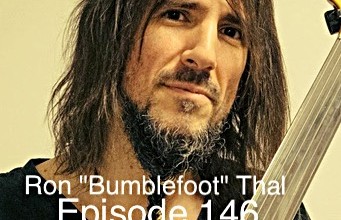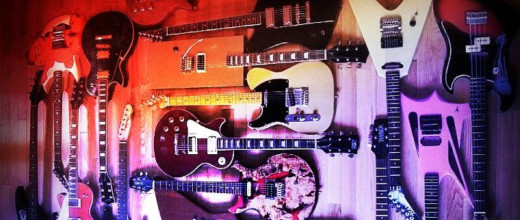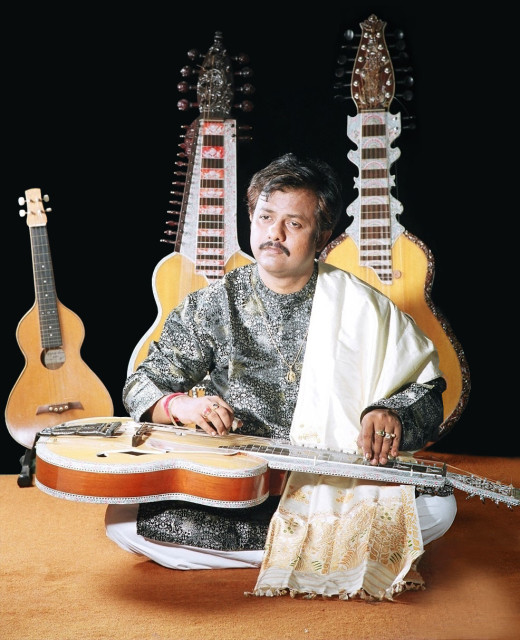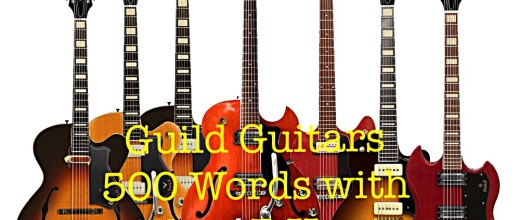Ron “Bumblefoot” Thal- We step into the mind of this brilliant musician.
More Ron?- http://www.bumblefoot.com

Ron “Bumblefoot” Thal- We step into the mind of this brilliant musician.
More Ron?- http://www.bumblefoot.com

What a thrill to speak with the man I have followed for years and have always admired, the very cool Dan Erlewine.
Go visit Dan- http://www.danerlewine.com
Dan in the shop with the guitar that killed folk!-
Dan on lead guitar in the early days with the Prime Movers-

500 Words: More Guitarists You Should Know
Recently I talked to some one about guitarists and they asked me who I thought was my favorite guitarist was and in the spur of the moment I sputtered out the name Bill Frisell.
They stared at me blankly and said “Who?”
For every Jimi Hendrix there is a talented “nobody” just waiting to be discovered.
Pandit Debashish Bhattacharya: The godfather of the Indian slide guitar. Not only did Bhattacharya invent the instrument he was one of the instrument’s foremost players. Bhattacharya’s melody and rhythm verges on superhuman and fans of every genre should listen to him.

Pete Cosey: Cosey was a sessions guitarist for Chess Records and made his name backing the likes of Etta James, Muddy Waters and Howlin’ Wolf and, most notably, Miles Davis. Cosey’s fuzzed out funky mayhem can be heard on many records especially Herbie Hancock’s “Future Shock”.
Leslie Harvey: Harvey was the brilliant but ill-fated guitarist for the short-lived Scottish group Stone the Crows. If he hadn’t been accidently electrocuted I have little doubt he would have taken his place amongst the great UK guitarists like Paul Kossoff and Mick Taylor.
Eric Bell: Bell was the original guitarist for Thin Lizzy and was a seminal member of the band when they were still a trio. After leaving Lizzy, Bell joined the Noel Redding Band and recorded several solo records.
Jef Lee Johnson: I stumbled across Johnson on YouTube and was just floored by this guy’s immense talent. Powerful, sensitive, melodic, funky, tasteful the guy was the real deal. He was so good he may make you want to quit.
James Blood Ulmer: Is there a genre called “fee blues”? If not, there should be. James Ulmer fuses the free jazz elements of Ornette Coleman with the gut wrenching emotional impact of Skip James and has created something unique.
Tuck Andress: Andress is another guitarist that re-defines what is possible with a guitar. Tuck’s two-handed techniques would shame any practitioner of this approach but because he’s a “jazz player” he’s criminally overlooked.
St. Vincent: Annie Clark a.k.a. St. Vincent is a player that walks a precarious line. St. Vincent has somehow been able to find a middle ground between pop and avant-garde and is the fist woman to have a signature guitar from Music Man.
Kim Simmonds: Savoy Brown is one of those bands that should have been superstars but weren’t. For those that like the swamped out boogie vibe of Foghat, check out Savoy Brown’s excellent “Hellbound Train”.
Killick Hinds: Hinds is impossible to pigeonhole because he plays experimental acoustic music and he has the biggest pedalboard this side of Phil Keaggy. A bit of advanced warning, he’s not every one’s cup of tea. Some people may find him a bit off putting but you can’t fault him for thinking outside of the box.
Special mentions:
Deborah Coleman: the napalm of blues.
Emily Remler: Modern electric jazz player.
Mary Osborne: An under appreciated jazz great.

For More on True Texas Tone- http://www.blumentritt.us

500 Words When to Liquidate Your Gear
There are countless articles in music periodicals urging people to buy gear I doubt there is the same number of articles talking about when to sell.
It’s an uncomfortable scenario to be sure its also one that every player will have to face sooner or later.
Even Eric Clapton sold off a sizeable amount of his gear.
I know that I’ve had to sell off a good amount of my stuff so maybe my experiences may take some of the sting out of the process:
Redundancy. At one point I wound up with three Stratocasters. I love Strats but since I’m not a touring musician I didn’t need three. One afternoon I played each back to back and kept the one that really spoke to me.
Damage. Every guitar or amp or stomp box is going to experience its share of knocks. Sometimes the damage to the item is so severe that it surpasses the value of the equipment. Snap the headstock off of a Chinese made Epiphone? It may be less expensive to buy a new one rather than to have it repaired.
Economy. As loath, as I am to admit it I’ve experienced long stretches of unemployment. At a certain point, the question becomes what is more important, a closet full of gear, or a roof over your head. The last time I checked a Les Paul wasn’t listed on Maslow’s hierarchy of needs, food and shelter, however, are.
Downsizing. Somewhat related to the economy but it doesn’t necessarily mean you need to loose a job. Say you working for a company and they transfer you to another office clear across the country, how much gear do you really want to haul with you? Maybe you get a significant other in your life and you have to make room for their stuff.
You’re old. Jake and Elwood haven’t knocked on your door to say, “We’re getting the band back together”. Do you really still need that Fender Super Showman full stack? Probably not. Would a smaller amp still achieve a full chub? Probably. With clubs and studios insisting that players use smaller amps perhaps you may have more amp than you really need.
Injury. That’s another difficult subject. Django was able to make due with a mangled hand and so were Jerry Garcia, Tony Iommi, and Les Paul. There are also a good number of players that have been able to do very well with missing hands also. But the loss of wages and costs surrounding physical therapy may necessitate the liquidation of some gear in order to make ends meet.
You want some new gear. “Goldernit that Wangblaster is a dang sexy guitar”. I hear you say. “But, looky here, a closet jammed with Footstompers, Earwreckers, and Freakmagnets gathering dust”. Time to get busy on eBay.
Hopefully, you may never find yourself making these sort of hard decisions but if you do, be methodical, and make sure you have your priorities right. The world is full of guitars even if you have to let a few go.

For More on Samantha Fish- http://www.samanthafish.com
For More on Diana Rein- http://www.dianarein.com

500 Words Guild Guitars
I’ve made no secret of being a fan of Guild guitars. My late nineties Bluesbird has been my constant companion ever since I bought it. When I wrote for Premier Guitar I used my Bluesbird as my go to guitar for every amp review I did even if I didn’t mention it in the article.
But who is Guild Guitars? The answer depends when you asked the question. Like many well-known brands Guild has been bought and sold many times since its formation in 1952.
Like Epiphone, Gretch, and CF Martin Guild also had its origins in New York. Also like Ephiphone and Gretch, Guild had gone through many ownership changes until the present day.
When Gibson bought Epiphone in 1952 Guild former Epiphone executive George Mann and music shop owner Alfred Dronge formed Guild. Early on Guild attracted many top players including Johnny Smith, George Barnes, and Duane Eddy.
The partnership between Mann and Dronge was a short one. After a year Mann left Guild leaving Dronge in charge.
By 1956 Guild had become successful enough to outgrow their original facilities and relocated to Hoboken New Jersey.
As Guild guitars continued expanding Guild made the unusual decision to keep their offices in Hoboken but move their productions to Westerly, Rhode Island. This proved to be a fatal decision to Alfred Dronge because he was killed in his private plane in 1972 while en route to visit the Westerly facility.
With the loss of Dronge Guild guitars limped on through the seventies and in 1995 Guild was purchased by Fender Musical Instruments.
In late 2001 Fender closed all Rhode Island productions and began making Guild guitars in Corona California.
2008 brought new changes as Fender Musical Instruments bought Kaman Music Corp and started making Guild guitars in New Hartford Connecticut.
In 2014 Fender sold Guild to California-based Cordoba Music Group and began some manufacturing in Oxnard California and began having some reissued models produced in the Far East.
The list of Guild players reads like a whose who of popular music and Guild guitars have found their way into the hands of players such as Ryan Adams, Jerry Garcia, Richie Havens, Bruno Mars, Brian May, Michael Nesmith, Tommy Smothers, Kim Thayil, Muddy Waters and Paul Weller.
With Gibson and Fender having the lion’s share of the American guitar market why did players gravitate towards this relative unknown? My cynical side says, “Because they were paid to” but the player in me says, “because they are well made” and “they have a gutsy sound”.
As I am writing this I saw that Guild had reissued “my” guitar. Even though there are some cosmetic changes to the new Bluesbird I will say the iced tea burst is dead sexy.
What does the future hold for Guild? Without the machinery of Fender behind them or the name recognition of Gibson or PRS they’ll never be one of the top three but I don’t see them going away again either. At sixty-four years old, you should look so good.